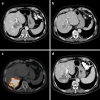The role of 90Y-radioembolization in downstaging primary and secondary hepatic malignancies: a systematic review
- PMID: 27512689
- PMCID: PMC4960274
- DOI: 10.1007/s40336-016-0172-0
The role of 90Y-radioembolization in downstaging primary and secondary hepatic malignancies: a systematic review
Abstract
Radioembolization (RE) is an emerging treatment strategy for patients with primary hepatic malignancies and metastatic liver disease. Though RE is primarily performed in the palliative setting, a shift toward the curative setting is seen. Currently, hepatic resection and in selected cases liver transplantation are the only curative options for patients with a hepatic malignancy. Unfortunately, at diagnosis most patients are not eligible for liver surgery due to the imbalance between the necessary liver resection and the remaining liver remnant. However, in borderline resectable cases, tumor volume reduction and/or increasing the future liver remnant can lead to a resectable situation. The combination of selective tumor treatment, the induction of hypertrophy of untreated liver segments, and its favourable toxicity profile make RE an appealing strategy for downstaging. The present review discusses the possibilities for RE in the preoperative setting as a downstaging tool or as a bridge to liver transplantation.
Keywords: Bridge to transplant; Downstaging; Future liver remnant; Radioembolization.
Figures


References
-
- Mosadeghi S, Liu B, Bhuket T, Wong RJ. Sex-specific and race/ethnicity-specific disparities in cholangiocarcinoma incidence and prevalence in the U.S.: an updated analysis of the 2000–2011 surveillance, epidemiology, and end results registry. Hepatol Res. 2015 - PubMed
Publication types
LinkOut - more resources
Full Text Sources
Other Literature Sources
